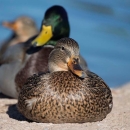Seasons of Wildlife
Spring
Resident Canada geese set up nesting territories on the Snake River islands in early March, and goslings hatch by mid-April. At the same time, large numbers of white-fronted and snow geese gather on the Snake River below Homedale and Weiser for up to a month before continuing their northward migration. In late April and May watch for migrating songbirds.
Bald eagles, osprey and great horned owls nest on both refuge units, with most feeding nestlings by the end of April. Great blue herons, black-crowned night herons and double-crested cormorants get a slightly later start, nesting in large rookeries on some of the Snake River islands in April and May.
Summer
In early summer, western grebes dance on Lake Lowell while resident bald eagles look for food for their young. Visitors can see large numbers of white pelicans on the lake and large broods of Canada geese on pastures and fields adjacent to the Snake River.
By late July and early August, mallards and wood ducks begin to congregate on the lake, looking for food in flooded vegetation. As summer progresses and the lake is slowly drawn down for irrigation, large numbers of shorebirds come to feed on the exposed mudflats. Look for dowitchers, sandpipers, godwits, yellowlegs and plovers.
Fall
As fall approaches, the number of birds using the refuge increases. The large, exposed mud flats continue drawing vast numbers of shorebirds. Resident flocks of ducks and up to 6,000 Canada geese are usually on Lake Lowell by the second week of October.
As colder weather drives migrating ducks and geese south, migratory birds join the resident birds at the lake. Some birds pass through, while others spend the winter. By mid-Nmovember, the goose population peaks at up to 15,000 birds.
Winter
Duck populations peak in mid-December, with up to 150,000 on Lake Lowell. Mallards predominate, but you might also see smaller numbers of northern pintail, American wigeon, green-winged teal, wood duck, common merganser, and northern shoveler. The Snake River also provides a winter home for a variety of ducks and geese.
Geese and ducks roost on the lake at night, their activity usually keeping patches of water open all winter. At dawn, they depart in large flocks to feed in the surrounding area. Visitors can see these feeding flights of ducks and geese at dawn or dusk, or view the large flocks of geese that feed on refuge farm fields during the day. Bald eagles, which move into the area to feed on weak and injured birds, can often be seen around the lake.
Check the iNaturalist and eBird pages for recent sightings at the refuge.
Featured Species
Deer Flat National Wildlife Refuge protects beautiful habitats that are home to a wide variety of animals and plants. The refuge is managed in part for migratory birds. It provides a significant resting and wintering area for birds migrating along the Pacific Flyway, including spectacular concentrations of mallards, snow geese and Canada geese. The sagebrush sagebrush
The western United States’ sagebrush country encompasses over 175 million acres of public and private lands. The sagebrush landscape provides many benefits to our rural economies and communities, and it serves as crucial habitat for a diversity of wildlife, including the iconic greater sage-grouse and over 350 other species.
Learn more about sagebrush uplands, riparian riparian
Definition of riparian habitat or riparian areas.
Learn more about riparian forests, and wetlands at the lake and the islands provide places to rest and refuel for many songbirds migrating through southwest Idaho in the spring and fall. In late summer and fall, mudflats at Lake Lowell, and along some refuge islands, provide resting and refueling habitat for migrating shorebirds.
The refuge also hosts some migratory insects who can migrate hundreds or thousands of miles! These include monarch butterflies and green darner dragonflies.
The Lake Lowell Unit hosts one of the three largest nesting colonies of western and Clark’s grebes in Idaho. Breeding populations of both species are considered imperiled by the State of Idaho. Western and Clark’s grebes spend almost all their time in water, even weaving floating nests from plants that grow in the lake.
Deer Flat Refuge is also a year-round home to some resident wildlife. You can see some residents all year: mule deer; coyotes; great blue herons; California quail; and raptors like bald eagles, red-tailed hawks and norther harriers. Other resident wildlife you will see only at certain times of the year. Either because they hibernate, like yellow-bellied marmots, gopher snakes, Pacific tree frogs and many insects. Or because they have a less visible life stage during some parts of the year, like dragonflies, midges, some butterflies and other insects.





